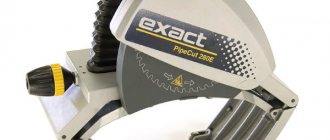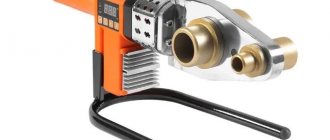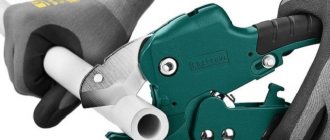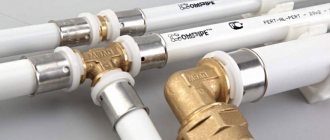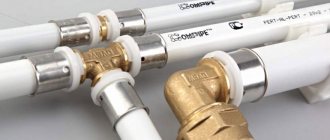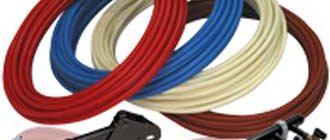New materials are released around the world every day. PVC, metal-plastic, polypropylene pipes are not uncommon for a long time. But scissors for cutting them are still a novelty. Our compatriots who are not involved in professional repairs use household tools. Not all pipes lend themselves easily to such “execution,” and then cutting turns into a living hell.
Ordinary scissors will also not give an even cut. And, as a result, you have to spend time on reworking and polishing. A poorly connected pipe will cause a leak. Pipe cutters solve this problem.
There are scissors for polypropylene , PVC and metal-plastic pipes. They, in turn, are divided into several varieties:
- Precision. Inexpensive scissors equipped with a ratchet. They have a simple design with high reliability. The price varies depending on the pipe section. The larger the diameter the scissors cut, the higher the cost.
- Automatic. Suitable for cutting pipes of any cross-section in hard-to-reach places. Made in the form of a pistol. Requires less human effort.
- Roller type pipe cutters. These scissors are available in two types on the market: cheap models use a threaded drive, while more expensive ones use a ratchet mechanism.
- Electric pipe cutter. Powered by electricity, no muscle force is applied. For proper operation, the pipe is fixed and the shears are started. Wait a little and you will get a perfectly even cut. The main disadvantage of an electric pipe cutter is the small cutting diameter. He will not accept pipes larger than 42 mm.
Below you will find reviews of the most popular models, their characteristics, pros and cons.
Rothenberger
Today, the best solution for polymer pipes is Rokut TC 75 . This model is made of high strength aluminum. Suitable for professional use. Cuts pipes up to 75 mm – one of the highest performance. Service life is several years. The average cost is 4000 rubles .
Rockut TC 75
- Precise, defect-free cutting at 90 degrees.
- Ratchet mechanism.
- High quality blade.
- Almost no force is expended during cutting.
- Blade opening when pressing a button.
- The handle is rubberized.
- None
Review:
In my opinion, the best tool today. Take it, you won't regret it. It cuts accurately and evenly and has been in service for two years now.
Best Scissor Pipe Cutters
Scissor-type pipe cutters have not lost their relevance with the advent of newer models. This is the most convenient tool that quickly cuts plastic pipes, but aluminum or copper products are not suitable for it. The blade flattens metal, so scissor models are used exclusively on plastic. And here it is important that the blade is as sharp as possible and the mechanism is smooth. With excess pressure in one press, the tool breaks the edge. Otherwise, this tool has no technical features. And you should choose it based on considerations of personal convenience.
KRAFTOOL
An excellent model for the home – EXPERT 42 mm KRAFTOOL 23381-42_z01 . It has a long service life and low weight. These characteristics contribute to ease of use. Suitable for professional use. The bracket fixes the scissors in one position. It makes it easier to transport the pipe cutter. The average price is 900 rubles .
EXPERT 42 mm KRAFTOOL 23381-42_z01
- Weight 360 g.
- Anti-corrosion coating.
- Smooth cut.
- Does not require significant muscle effort.
- Diameter over 32 mm is difficult.
- They rust.
- Requires tightening of fasteners.
Review:
The model is distinguished by its low weight - this is the main advantage of the tool. I advise you to try it. There are some disadvantages, but they are not critical. They cut pipes larger than 32 mm “with a creak”
How to sharpen scissors for cutting polypropylene pipes
The sharp sharpening of the tool blade guarantees easy cutting and an even cut. If the cutting edge has become dull, it is quite possible to return the pipe cutter to working condition. To do this, it is recommended to contact a workshop with a turning specialist, or handle the task yourself.
The sharpening angle is maintained at 30 degrees. The main tool used is a grindstone with medium to fine grain. Water or honing oil is also useful, which not only gives the tip the desired shape, but also extends the service life of the cutting edge.
To begin with, the pipe cutter is disassembled to remove the knife. To do this, use screwdrivers, pliers and other tools. Next, the surface of the cutter is wiped with water or oil, and then brought to a rotating abrasive wheel. The blade is applied to the stone with the beveled edge down, maintaining an angle of 30 degrees. Without lifting the knife from the abrasive, perform movements away from the stone towards yourself (several times).
Sharpening the pipe cutter blade is carried out in two stages. First, the stone is passed with a coarse abrasive, then with a fine one.
The quality of sharpening is checked by making a test cut on the pipe.
Gross
Gross 78420 is used for cutting PVC pipes, baseboards, PVC fillets, and hoses. The pipe cutter is equipped with a trapezoid-shaped knife. Gros has two cutting edges. The tool is made of high quality steel. The ratchet mechanism is improved, the handle is made of three components. The average price is 1000 rubles .
Gross 78420
- High carbon steel blade.
- Light weight 440 g.
- Three-component handle.
- Additional work desk.
- No.
Review:
I liked the model. Average weight. If you work for a long time, you will get tired, but it is made with high quality, and the price is low
Premium class
2nd place: “MGF UNIQUE 63”
This sample is freely capable of working for polymer products with a diameter of up to 63 millimeters. It has a serious 1080 alloy blade, which means it can easily cut PP, PVC and PE based polymers. The use of this unit is to obtain high hardness of the gaps. The manufacturer has provided a locking hook, which is responsible for the safe movement and storage of the device. The built-in chamfer ensures proper cutting, and the well-placed lever mechanism only confirms it. In general, the device is labeled as a low-effort tool, and most experts have no doubt about its performance and durability. The set price for stores is 6,200 rubles.
MGF UNIQUE 63
Advantages:
- High hard cutting edge;
- Level of work in the professional area;
- Very powerful ratchet.
Advantages:
- Not detected.
1st place: “REMS ROS P 42P”
This device is rightfully the best among the models from the German manufacturer in this line. Its accuracy can reach 1 millimeter, and when handled in the skillful hands of an operator, it can be even less and more correct. Practice shows that with traditional functionality there is no burr or extra chips left. The device is capable of working on any metal-plastic workpieces. The set includes replaceable blades that are hardened using an innovative method. Upon completion of the cutting stage, the blade automatically enters the protective groove. The quality of this device is determined at the European level. The established cost for retail chains is 6,700 rubles.
REMS ROS P 42P
Advantages:
- European quality;
- Excellent function for eliminating (collecting) chips;
- Increased accuracy.
Flaws:
- Not detected.
Rehau
REMS 291310 pipe cutter is battery operated. Suitable for cutting pipes up to 40 mm. Convenient for use in one-handed mode. The average price is 11,000 rubles .
pipe cutting scissors
- The blade is wedge-shaped.
- Weight 1.2 kg.
- Accelerated battery charging mode.
- No.
Review:
My first pipe cutter. Glad I settled on rehau. Good company. A bit pricey, but does the job well
The best rotary pipe cutters
The operating principle of a rotary pipe cutter is somewhat different from the usual scissor type. It does not have a blade, and the cutting element is a small diamond disk. The same technology is used on glass cutters, only here the disc is placed in a round housing. To cut a pipe, you need to place it in the seat, press the disk all the way, and rotate the tool around the pipe. The main advantage of this option is that it can cut not only plastic pipes, but also aluminum and copper structures. Thanks to the circular motion, the edge does not flatten and no burrs remain.
Comparative table of characteristics of the presented brands
| Model/brand | Diameter of cut pipe | Weight, kg | Pipe material |
| Rothenberger Rocut TC 75 | 0 – 75 mm | 1,5 | ppr pipes |
| Rothenberger Rocut TC 63 | 0 – 63 mm | 1,3 | Plastic PP |
| Rothenberger Rocut TC 50 | 6 – 50 mm | 0,6 | Plastic PP |
| Gross 78420 | 6 – 42 mm | 0,44 | PVC |
| Reed SC1 | 32 mm | 0,1 | Thin-walled plastic |
| Reed RSP1 | 42 mm | 0,4 | ppr pipes, PVC |
| Reed RS2 | 63 mm | 1,3 | PP |
| KRAFTOOL 23381-42_z01 | 42 | 0,36 | ppr pipes |
| Rehau REMS 291310 | up to 40 mm | 1,2 | Plastic (metal-plastic) |
General information about the tool
These are devices for performing manual cutting operations, so they are often used in the domestic sphere. For professional use, versions with a similar operating principle are intended, but with wider functionality - they are attached to the bed and cut in line mode. The fundamental difference between scissors for cutting plastic pipes, the photo of the standard model of which is presented above, is a strong structural base. As a rule, stainless and chrome vanadium alloys are used for working parts, providing high-quality cuts. There are also models with roller functional parts, thanks to which you can get even better results. After processing with such a tool, the edges of the pipes are smooth and completely suitable for joining.
User manual
Pipe cutters on the market are available in manual and electric models. Carefully read the instructions in the packaging for your model. The nuances of using pipe cutters differ, but there are general principles.
Typically, the pipe is placed into the pipe cutter exclusively perpendicularly. There must be a right angle between the ends, which is especially important for welded and fitting connections.
It is also necessary to control the process of fixing the tool handle, as this may affect the size of the workpiece.
You can find out more about the operating instructions for the tool in the video below.
RESANTA ASPT-1000
- Coupling method of connecting pipes
- Sword-shaped heater
- Pair welding nozzle
- Power - 1000 W
- Maximum heating - 320°
- Includes 6 nozzles
- Nozzle coating: Teflon
- Production - Russia
The next nominee in my rating is one of the most inexpensive soldering irons on the market, RESANTA ASPT-1000. Among analogues in its price segment, this model stands out for its performance and quick start. The maximum power of the heater is 1000 W, and the operating temperature is adjustable in the range of 50-300 degrees. These parameters will not overload your home network, but the soldering iron will cope with its tasks. Welding tools from Resanta allow you to connect a wide range of pipes and fittings made of polymers, the diameters of which vary between 20-63 mm. And complete matrices in the amount of 6 pieces allow you to glue parts of standard sizes; a special Teflon coating increases their service life. The soldering iron is equipped with indicators that indicate the connection of the unit to the electrical network and the heating temperature. Green and red colors indicate the current state of the device. The soldering iron comes with a suitcase, a screwdriver, a key, protective gloves and a user manual. There is also a stand on which you can place the device during breaks in work. Users who purchased this soldering iron model are satisfied with the device’s packaging, its light weight and long power cord. But, despite the fact that the sword-shaped heater has three holes for installing matrices, the user will not be able to install several pairs at the same time: the holes are too close to each other.
What are there
The best manufacturers produce popular models of the following types:
- Manual. Needed for DIY repairs at home. They can handle a small amount of work. They are distinguished by their compactness, lightness, noiselessness, and mobility.
- Electrical. They work using an electric motor. The performance is significant. Used to perform a large volume of work in a limited period of time. Requires a power source, which limits its range of capabilities. Battery models are independent of electricity. The noise level is superior to similar products.
- Hydraulic. The main feature is high power. The work uses hydraulic fluid, so the models are heavy and have limited mobility. In most cases, stationary devices are produced, but mobile options can also be found on store shelves. One of the varieties is electro-hydraulic devices. They operate in conjunction with an electric drive.
- Pneumatic. They are driven by compressed air pumped by a compressor unit. Efficient device with low noise level.
The tools differ in their operating principles, and therefore they are divided into the following types:
- Roller. Used for fixed products in confined spaces. The cutting element is rollers, the number of which varies from one to four. Single-roller ones are designed for products with a diameter of up to 50 mm, four rollers can cope with a diameter of up to 100 mm.
- Guillotine. The main difference is ensuring uniform blade pressure over the entire cross-sectional area. The main purpose is for polypropylene structures, since it guarantees the absence of deformation of the product during the cutting process. Popular models are available with a lever and screw feed.
- Incisive. The main task is to cut thick-walled or thin-walled polymer and metal pipes. There is a rotating disk as the cutting part.
- Scissors. Scissor pipe cutters are used for reinforced plastic and plastic structures. Visually they resemble metal scissors. A distinctive feature is the presence of jaws with an adapted cylindrical profile. The blade used as a cutting element is a sharpened blade. Not recommended for use when working with thin-walled and metal products.
- Telescopic. A type of roller. They are also called universal. In addition to cutting rollers, there are guides and a carriage, which makes it possible to work with products of various sizes. The possibility of adjustment allows the tool to be used for stainless corrugated products. The best manufacturers have launched the production of telescopic models with a built-in deburring device.
- Ratchet. A subtype of scissor tool. The principle of operation is the closure of several handles. Thanks to special toothed racks, after finishing the cut the blade returns to its original position.
- Orbital. They are floor-mounted or tabletop electric machines on which workpieces are fixed using clamping jaws. They work with products made of non-ferrous and ferrous metals, plastic and stainless steel. Detachable and one-piece models are available.
- Chain. Recommended for working with fragile compounds: concrete, cast iron, ceramics. The basis of the design is a chain, where the links are connected using cutting rollers, making the cutting process high-quality and uniform.
- With clamp type latch. They are distinguished by the presence of a rigid type of fixation, which is located along the entire diameter. Rollers are used as the cutting element, which can be replaced if necessary. This made it possible to increase the service life declared by the manufacturer. The adjustable handle makes it possible to use the unit in hard-to-reach places. Area of use: cutting large pipes and thick walls.
- C-shaped mini pipe cutters. The cutting part is discs. Able to work in confined spaces. It is distinguished by its lightness, convenient shape, and compactness. Able to make a cut in any hard-to-reach place.

